
The Trans-Andean railways provide rail transport over the Andes. Several are either planned, built, defunct, or waiting to be restored. They are listed here in order from north to south.

The Trans-Andean railways provide rail transport over the Andes. Several are either planned, built, defunct, or waiting to be restored. They are listed here in order from north to south.
Much of Ecuador's Trans-Andean Railway (a railway network that once ran from Guayaquil to Quito) has been rendered useless by natural disasters. Torrential rains from the 1982–83 and 1997-98 El Niño caused massive landslides that damaged the railway line. The network is operated by Empresa de Ferrocarriles Ecuatorianos . Only three sections remain operational: a 60-kilometre (37 mi) segment connecting Quito and Cotopaxi National Park, a 43.5-kilometre (27 mi) stretch between Ibarra and Primer Paso, and the mountainous five-hour, 100 km (62 mi) excursion from Riobamba to Sibambe.
Although wholly within Peru, the Ferrocarril Central Andino (FCCA; the former Ferrocarril Central del Perú) running inland from Callao and Lima crosses the Andes watershed at Galera en route to La Oroya and Huancayo. [2] From here the route is extended by the Ferrocarril Huancayo - Huancavelica. In July 2006 FCCA began work to regauge the Huancavelica line from 914 mm (3 ft) to 1,435 mm (4 ft 8+1⁄2 in) (standard gauge). There was also a proposal for a 21 km (13 mi) tunnel under the Andes. [3]
The Ferrocarriles del Sur del Perú (FCS), now operated by PeruRail, runs from the coast at Matarani to Cuzco, and to Puno on Lake Titicaca from where steamers and train ferries have been run connecting with Guaqui in Bolivia. [4]
Empresa Nacional de Ferrocarriles - ENFE, operator of the National Railways of Bolivia, and consultant Hagler Bailly, United States, have signed a contract to undertake an economic feasibility study into the proposed $US 1 billion 338 km Aiquile – Santa Cruz Railway (IRJ July p6). The line would connect the Eastern Railway network with the Andean Railway network, and effectively create a new trans-Andean railway from Pacific Ocean ports in Chile to the port of Santos in Brazil. [5]
Other Bolivia-Chile railways:
In 2014, proposals were advanced by ProInversión for the above railway. [6] [7]
The Huaytiquina railway is a single 1,000 mm (3 ft 3+3⁄8 in) gauge linking Salta, Argentina, to Antofagasta, Chile. The Tren a las Nubes is a touristic service running for 217 kilometres (135 mi) on the Argentinian side.
The central Transandine Railway from Valparaíso, Chile, to Mendoza, Argentina is defunct, pending reconstruction. [8] While Chile and large parts of Argentina both use the same 1,676 mm (5 ft 6 in) gauge, the connecting Ferrocarril Trasandino Los Andes - Mendoza used a narrow gauge of 1,000 mm (3 ft 3+3⁄8 in) with rack railway sections. Thus there are two break-of-gauge stations, one at Los Andes, Chile and the other at Mendoza.
In 2009, a deal was signed to build a 1,676 mm (5 ft 6 in), single gauge, base tunnel connecting Chile and Argentina[ citation needed ].

Transport in Chile is mostly by road. The far south of the country is not directly connected to central Chile by road, and water transport also plays a part there. The railways were historically important in Chile, but now play a relatively small part in the country's transport system. Because of the country's geography and long distances between major cities, aviation is also important.
This article describes the transport in Peru.

Transport in Argentina is mainly based on a complex network of routes, crossed by relatively inexpensive long-distance buses and by cargo trucks. The country also has a number of national and international airports. The importance of the long-distance train is minor today, though in the past it was widely used and is now regaining momentum after the re-nationalisation of the country's commuter and freight networks. Fluvial transport is mostly used for cargo.
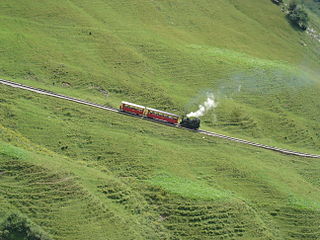
A mountain railway is a railway that operates in a mountainous region. It may operate through the mountains by following mountain valleys and tunneling beneath mountain passes, or it may climb a mountain to provide transport to and from the summit.
The Empresa Nacional de Ferrocarriles del Perú (Enafer) is a public company which ensures the management and the commercial use of the railway network of Peru.
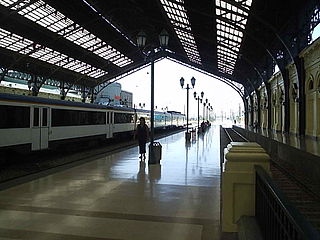
Empresa de los Ferrocarriles del Estado is the national railway and the oldest state-run enterprise in Chile. It manages the infrastructure and operating rail services in the country.
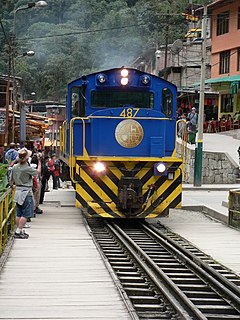
PeruRail is a railway operator providing tourist, freight, and charter services in southern Peru. It was founded in 1999 by two Peruvian entrepreneurs and the British company Sea Containers.

Rail transport in Peru has a varied history. Peruvian rail transport has never formed a true network, primarily comprising separate lines running inland from the coast and built according to freight need rather than passenger need.

The Transandine Railway was a 1,000 mmmetre gauge combined rack and adhesion railway which operated from Mendoza in Argentina, across the Andes mountain range via the Uspallata Pass, to Santa Rosa de Los Andes in Chile, a distance of 248 km. The railway has been out of service since 1984, and has been partly dismantled. There has been talk about restoring the railway, but there is currently no indication of any restorative work underway.

The Ferrocarril de Antofagasta a Bolivia is a private railway operating in the northern provinces of Chile. It is notable in that it was one of the earliest railways built to 2 ft 6 in narrow gauge, with a route that climbed from sea level to over 4,500 m (14,764 ft), while handling goods traffic totaling near 2 million tons per annum. It proved that a railway with such a narrow gauge could do the work of a standard gauge railway, and influenced the construction of other railways such as the Estrada de Ferro Oeste de Minas. It was later converted to 1,000 mmmetre gauge, and still operates today.

Ferrocarril Central Andino (FCCA) is the consortium which operates the Ferrovías Central railway in Peru linking the Pacific port of Callao and the capital Lima with Huancayo and Cerro de Pasco. As one of the Trans-Andean Railways it is the second highest in the world constructed by the Polish engineer Ernest Malinowski in 1871–1876.
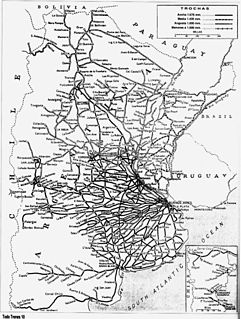
The Argentine railway network consisted of a 47,000 km (29,204 mi) network at the end of the Second World War and was, in its time, one of the most extensive and prosperous in the world. However, with the increase in highway construction, there followed a sharp decline in railway profitability, leading to the break-up in 1993 of Ferrocarriles Argentinos (FA), the state railroad corporation. During the period following privatisation, private and provincial railway companies were created and resurrected some of the major passenger routes that FA once operated.
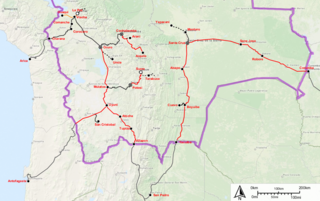
The Bolivian rail network has had a peculiar development throughout its history; owing to losses of land, prestige and credit rating due to the failure of the War of the Pacific, railway development came late to Bolivia. The demand for mineral wealth and communication to the inland city of La Paz, encouraged foreign investors, mainly British, to construct railways. However, into this mix came the experience of railway building in adjacent Peru, whereby overbuilding of 4 ft 8+1⁄2 instandard gauge line across the high Andes meant that Peru went bankrupt.

The Arica–La Paz railway or Ferrocarril de Arica–La Paz (FCALP) is built by the Chilean government under the Treaty of Peace and Friendship of 1904 between Chile and Bolivia. The railway line was inaugurated on 13 May 1913 and is the shortest line from the Pacific Coast to Bolivia. It is 440 km (273 mi) long, of which 233 km (145 mi) is in Bolivian territory. The Railway is meter gauged. However, until 1968, it was rack worked over a 43 km section, on the Chilean side, between Central and Puquios. The line reaches a height of 4257 meters above sea level at General Lagos. The Chile - Bolivia border is crossed between the stations of Visviri and Charaña. When the railway is in operation, it is used for the export of Bolivian minerals and some agricultural production as well as the import of merchandise into Bolivia.

The history of rail transport in Chile has gone through several periods of boom and bust. It began in 1840, with the construction of the first branch in the north. Further construction proceeded apace linking cities from Pisagua all the way to Puerto Montt.

The Salta–Antofagasta railway, also named Huaytiquina, is a non-electrified single track railway line that links Argentina and Chile passing through the Andes. It is a 1,000 mmmetre gauge railway with a total length of 941 km, connecting the city of Salta (Argentina) to the one of Antofagasta (Chile), on the Pacific Ocean, passing through the Puna de Atacama and Atacama Desert.

Richard Fontaine Maury was an American railway engineer and naturalized Argentine. He became known for the project of the Argentine "Ramal C-14" of the Ferrocarril General Manuel Belgrano and the touristic Tren a las Nubes.

The Huancayo Metro or Wanka Metro is a failed metropolitan railway project which was to be the second metro line in Peru, after Lima Metro. It was constructed by the company Ferrocarril Central Andino in the city of Huancayo in the Central Andes of Peru. Its operation was planned for the first half of 2013, as announced in October 2012, However the railway never opened
Metre and 3 ft gauge lines are found in South America. Some of the 1,000 mm gauge lines cross international borders, though not as efficiently as they might.
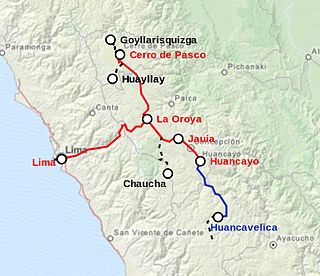
The Huancayo-Huancavelica Railway, also known as Tren Macho is a state-owned, non-electrified, single-track, 128.7 km long, standard gauge railway connecting the cities of Huancayo and Huancavelica in the central highlands of Peru. The railway is operated by the Peruvian Ministry of Transport and Communications (MTC) but is expected to be operated as a concession from the end of 2019.
{{cite web}}: Missing or empty |title= (help)